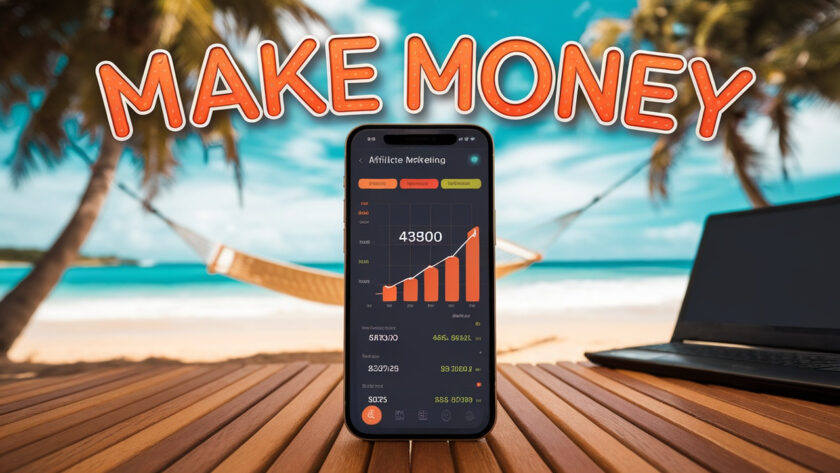Have you ever wondered how bloggers and influencers consistently earn income through their content? The answer often lies in affiliate marketing. This powerful strategy connects brands with content creators, enabling both to thrive in the digital marketplace.
As an affiliate marketer, you promote products or services from brands and earn a commission for every sale made through your unique affiliate link. Whether you’re sharing through blogs, social media, or videos, affiliate marketing offers a win-win situation. Brands gain access to your dedicated audience, while you earn a steady income stream.
Programs like Shopify and Amazon Associates exemplify how affiliate marketing works in real life. By leveraging affiliate links, marketers can promote high-quality products and services, earning commissions that range from a few dollars to thousands. This method is versatile, supporting both full-time entrepreneurs and those looking for a side hustle.
With the right strategy, affiliate marketing can become a stable source of income. It’s a method that’s easy to start but requires dedication to master. Whether you’re new to the field or looking to expand your current efforts, understanding the ins and outs of affiliate marketing is essential for success in today’s competitive digital landscape.

Introduction to Affiliate Marketing
In today’s digital landscape, affiliate marketing has emerged as a cornerstone of online business strategies. Its growth has been exponential, with millions now leveraging this model to connect brands with consumers.
The Rise of Affiliate Marketing in the Digital Age
The surge of affiliate marketing can be attributed to the proliferation of digital channels like blogs, social media, and video content. These platforms have created fertile ground for affiliates to promote products, earning commissions for every sale made through their unique links.

This performance-based model has become a preferred method for both brands and content creators. Brands gain access to targeted audiences, while affiliates earn income by promoting products they believe in.
Understanding Its Role in Modern Online Business
Affiliate marketing has revolutionized how businesses reach customers. By partnering with influencers and content creators, brands can tap into niche audiences, enhancing their visibility and driving sales.
The affiliate marketing industry is supported by networks like Amazon Associates and Shopify, which provide the infrastructure for affiliates to promote products seamlessly. These platforms offer tools and tracking systems that make it easier for affiliates to manage their campaigns effectively.
Successful affiliate marketing campaigns often hinge on trust and relevance. When affiliates endorse products that resonate with their audience, it fosters loyalty and increases conversion rates.
What Is Affiliate Marketing And How Does It Work?
Affiliate marketing is a powerful way for marketers to earn income by promoting products or services from brands. Through unique affiliate links, you can connect customers to businesses and earn a commission for each sale made.
Defining the Core Concept
Affiliate marketing is straightforward. You join a program, get your link, and share it. When someone clicks and buys, you earn. It’s a win-win for everyone involved.
How Affiliates Earn Commissions
There are a few ways to earn. Pay-per-sale is common, where you get a cut of the purchase price. Pay-per-lead pays for leads, like email sign-ups. Some programs even pay per click. The commission rates vary, from 5% for everyday items to 20% or more for high-ticket products.
| Program Type | Commission Structure | Examples |
|---|---|---|
| Pay-per-sale | Earn a percentage of each sale | Amazon Associates |
| Pay-per-lead | Get paid for generating leads | Insurance companies |
| Pay-per-click | Earn for each click on your link | Google AdSense |
Many programs are free to join, making it easy to start. Successful affiliates can even negotiate higher rates. Remember, it takes time to build an audience, but the potential for passive income is real.

Different Types of Affiliate Marketing
Affiliate marketing isn’t a one-size-fits-all strategy. It comes in various forms, each catering to different approaches and audience relationships. Understanding these types can help you choose the best fit for your goals.
Unattached Affiliate Marketing Explained
Unattached affiliate marketing focuses on broad, generic promotions. Affiliates don’t need expertise in the product. They often use paid ads like Google AdWords or social media campaigns. This method is great for those seeking passive income with minimal involvement. However, it tends to have lower conversion rates due to the lack of personal connection.
Related and Involved Affiliate Models
Related affiliate marketing involves promoting products within your niche. For example, a fitness blogger endorsing athletic wear. This builds trust and often leads to better conversion rates. Involved affiliate marketing takes it a step further by personally using the products. Sharing genuine experiences fosters deeper trust, resulting in higher credibility and conversion rates.
| Type | Approach | Conversion Rates |
|---|---|---|
| Unattached | Generic advertising | Lower |
| Related | Niche relevance | Medium |
| Involved | Personal experience | Higher |
Each type has its strengths. Unattached is ideal for passive income, while related and involved methods build trust and credibility. Choose the one that aligns with your audience and goals for the best results.
Pros and Cons of Affiliate Marketing
Exploring the world of affiliate marketing reveals both exciting opportunities and notable challenges. This section dives into the major benefits and potential drawbacks to help you make an informed decision.
Major Benefits for Affiliate Marketers
Affiliate marketing offers several advantages that make it appealing to many. One significant benefit is the low start-up cost. You can begin with minimal investment, often just a domain and hosting for a website. Additionally, the scalabilityof this model allows you to grow your income as your audience expands.
- Low-risk revenue model: Start with minimal investment and scale as you grow.
- Passive income opportunities: Earn commissions from content that continues to attract visitors over time.
- Flexibility: Promote products across various platforms like blogs, social media, or email.
For example, a blog post with affiliate links can generate income long after it’s published, demonstrating the potential for passive earnings.
Potential Challenges and Limitations
While the benefits are enticing, there are challenges to consider. Building a loyal audience takes time and consistent effort. Additionally, as an affiliate, you have limited control over product pricing or quality, which can impact your commission rates.
- Slower income growth: Success often requires months of consistent effort.
- Competition: Standing out in a crowded market can be difficult.
- Income fluctuations: Earnings may vary based on audience engagement and product demand.
For instance, promoting seasonal products may result in fluctuating income, highlighting the need for diversification in your strategy.
Understanding both the pros and cons helps you approach affiliate marketing with realistic expectations and a strategic mindset. By weighing these factors, you can make informed decisions that align with your goals and audience needs.
How Affiliate Marketing Works: Step-by-Step
Understanding the mechanics of affiliate marketing is crucial for maximizing your business potential. This section breaks down the process into manageable steps, helping you navigate from setup to success.
Promoting Affiliate Links and Driving Traffic
Your journey begins with obtaining affiliate links from programs like Amazon Associates or Shopify. Share these links across your blog, social media, or email campaigns to drive traffic. The goal is to attract visitors who are likely to click your links and make purchases.
Tracking Transactions and Conversion Attribution
Once a visitor clicks your link, a tracking cookie is placed on their browser. This cookie ensures you receive credit for any purchases made within a specified timeframe. Affiliate networks use advanced tracking systems to monitor conversions and attribute them to your unique links.
Understanding Various Commission Structures
Commission structures vary, offering flexibility for different business models. Pay-per-sale models reward you with a percentage of the sale price, while pay-per-lead models compensate you for generating leads. Some programs even offer recurring commissions, providing long-term income from repeat customers.
By following these steps and understanding the commission models, you can effectively manage your affiliate marketing campaigns. This structured approach helps you optimize your strategies, leading to increased conversions and higher earnings over time.
Identifying a Profitable Niche

Selecting the right niche is the first step toward a successful affiliate marketing journey. A well-chosen niche can drive consistent traffic, boost your income, and help you stand out in a crowded market.
Choosing Between Passion and Data-Driven Decisions
Your niche should blend your passion with market demand. While it’s important to choose something you care about, data-driven decisions ensure long-term profitability. Tools like Google Trends can reveal trending topics, helping you identify opportunities that align with your interests.
Researching Market Trends and Audience Demand
Understanding your audience is key to success. Analyze market trends to identify gaps in demand. For example, the wellness economy, valued at $4.4 trillion in 2022, offers lucrative opportunities in health and wellness. Similarly, the U.S. beauty market, which grossed nearly $49 billion, highlights the potential for high-demand products.
- Combine passion with solid market research for the best results.
- Analyze competition to find gaps in the market.
- Optimize for long-term income by selecting evergreen niches.
By balancing passion with data, you can pinpoint a niche that offers steady traffic, consistent income, and growth opportunities. Real-world examples, like the success of health and wellness niches, show how a well-defined niche can lead to lasting success.
Building Your Affiliate Platform
Creating a strong online presence is essential for affiliate success. Your platform serves as the foundation for all your marketing efforts, helping you connect with your audience and promote products effectively.
Establishing a Website or Blog as Your Hub
A website or blog is the cornerstone of your affiliate platform. It provides a dedicated space to share content, showcase products, and build trust with your audience. By owning your platform, you maintain control over design, content, and user experience. Regular updates with valuable content keep visitors engaged and attract repeat traffic.
Leveraging Social Media to Extend Your Reach
Expand your influence by integrating social media into your strategy. Platforms like Instagram and TikTok allow you to reach broader audiences. Share content, engage with followers, and use affiliate links to drive traffic to your website. Combining your website with social media creates a powerful system for promoting products and earning commissions.
| Platform | Features | Benefits |
|---|---|---|
| Website/Blog | Content creation, SEO, email capture | Establishes authority, evergreen content, high conversion potential |
| Social Media | Visual content, influencer partnerships, paid ads | Broader reach, real-time engagement, viral potential |
By building a website and leveraging social media, you create a robust affiliate platform that drives traffic and boosts conversions. Start by setting up your site, then expand your reach through social channels to maximize your affiliate marketing potential.
Essential Tools and Resources for Affiliate Marketers
To succeed in affiliate marketing, you need the right tools. These resources help you manage campaigns, track performance, and grow your income.
Exploring Affiliate Networks and Platforms
Affiliate networks connect you with companies offering products to promote. Popular networks include CJ Affiliate, ShareASale, and Impact. These platforms provide tools to track clicks, conversions, and earnings, making campaign management easier.
Utilizing Tracking and Analytics Tools
Tracking tools are crucial for monitoring your performance. Google Analytics helps you understand website traffic and customer behavior. SEMrush and Ahrefs offer insights into SEO and competitor strategies, while email marketing tools like Mailchimp help you engage with your audience effectively.
| Tool Type | Features | Benefits |
|---|---|---|
| Affiliate Networks | Product access, tracking, reporting | Connects with brands, simplifies tracking |
| Analytics Tools | Traffic analysis, SEO insights | Optimizes campaigns, improves ROI |
| Email Marketing | Campaign creation, automation | Builds customer relationships, boosts sales |
By leveraging these tools, you can streamline your efforts and maximize your affiliate marketing potential. Whether you’re focusing on email campaigns or optimizing your website, the right resources will help you achieve your goals and grow your business effectively.
Creating Compelling, Trustworthy Content
Quality content is the cornerstone of a successful affiliate marketing strategy. It’s what draws your audience in and keeps them engaged. By crafting detailed product reviews and tutorials, you provide value that resonates with your audience and builds trust.
Crafting Product Reviews and Tutorials
When creating reviews, focus on authenticity. Share personal experiences and highlight both pros and cons. Tutorials should be clear and actionable, guiding your audience through each step. This approach not only helps your audience but also positions you as an expert in your niche.
Optimizing Content for SEO and Engagement
To maximize your reach, optimize your content for search engines. Use relevant keywords naturally and ensure your meta descriptions are compelling. Engaging content, such as videos and infographics, can significantly boost click-through rates and keep your audience interested.
| Content Type | Key Features | Benefits |
|---|---|---|
| Product Reviews | Detailed analysis, pros and cons, personal insights | Builds trust, increases conversions |
| Tutorials | Step-by-step guides, actionable advice | Enhances engagement, positions you as an expert |
| SEO Optimization | Keyword research, meta tags, mobile optimization | Improves search rankings, drives organic traffic |
Integrating affiliate links naturally within your content ensures a seamless experience for your audience. By balancing informative content with persuasive calls-to-action, you can drive clicks and conversions without overwhelming your readers. Remember, the goal is to provide value first, which fosters trust and long-term engagement.
Driving Quality Traffic to Your Affiliate Links
Driving quality traffic to your affiliate links is key to boosting your conversion rate and growing your income. This section explores strategies to attract steady, targeted visitors using both organic and paid methods.
Implementing Organic Search Strategies
Organic search strategies are a cornerstone of long-term traffic growth. SEO plays a vital role in improving your website’s visibility on search engines. By optimizing your content with relevant keywords and creating high-quality, engaging material, you can attract visitors naturally.
Content optimization involves crafting compelling meta descriptions and titles. Tools like Google Analytics can help you track traffic sources and refine your approach. Over time, well-executed SEO can drive consistent, high-quality leads to your affiliate links.
Using Paid Advertising and PPC Campaigns Effectively
Paid advertising, such as PPC campaigns, offers a faster way to drive traffic. Platforms like Google Ads allow you to target specific audiences and optimize your ad spend for better results. Testing different ad variations can improve click-through rates and conversions.
Targeting the right audience is crucial. By focusing on demographics that align with your niche, you can increase the likelihood of conversions. Regularly monitoring metrics and adjusting your strategy ensures you maximize your ROI.
| Strategy | Benefits | Examples |
|---|---|---|
| Organic SEO | Long-term traffic, cost-effective | Google Analytics, meta descriptions |
| PPC Advertising | Quick results, targeted reach | Google Ads, social media ads |
Combining organic and paid strategies can yield the best results. By testing and optimizing your approach, you can drive quality traffic and increase your affiliate income.
Optimizing Affiliate Campaigns Through Data and Analytics
Data plays a crucial role in refining your affiliate strategies. By closely monitoring performance metrics, you can identify what works and what doesn’t, allowing you to make informed decisions to boost your earnings.
Monitoring Conversions and Performance Metrics
Start by tracking key performance indicators like click-through rates and conversion rates. These metrics reveal how well your campaigns are performing. Tools like Google Analytics can help you analyze traffic sources and user behavior, providing insights into where your audience is coming from and what actions they take on your site.
Adjusting Strategies Based on Data Insights
A/B testing is a powerful way to compare different campaign elements, such as headlines or calls-to-action, to see which ones drive better results. For example, you might discover that a specific landing page design significantly increases conversions. Use this data to refine your approach and allocate your resources more effectively.
Regularly reviewing your campaign data helps you spot trends and areas for improvement. For instance, if a particular product isn’t generating the expected commissions, consider adjusting your promotional strategy or switching to a different product. By continuously refining your approach based on data, you can optimize your campaigns for higher earnings.
Remember, data is your guide. It shows you where to focus your efforts and how to enhance your strategies. By leveraging analytics tools and staying attuned to performance metrics, you can make smarter decisions that drive real results for your affiliate marketing efforts.
Legal Considerations and Affiliate Disclosures
As you navigate the world of affiliate marketing, it’s crucial to understand the legal requirements that protect both you and your audience. Compliance with regulations ensures transparency and trust, which are essential for long-term success.
Understanding FTC Guidelines for Transparency
The Federal Trade Commission (FTC) mandates that all affiliate disclosures must be clear and conspicuous. This means your disclosures should be easy to find and understand. Place them near affiliate links or product mentions to ensure compliance. For example, a simple statement like “This post contains affiliate links” works well. The FTC also requires that disclosures be in plain language, avoiding any confusing terms.
Reviewing Affiliate Agreements and Compliance
Before joining any affiliate program, carefully review the terms to ensure you understand all requirements. For instance, Amazon Associates demands a specific disclosure on every page with affiliate links. Regularly check for updates to these agreements to stay compliant. Non-compliance can lead to penalties or even termination from programs.
Proper disclosures build trust with your audience. They show that you value transparency and are committed to ethical practices. This trust can lead to higher engagement and more conversions over time. For example, placing disclosures in your blog’s sidebar or at the top of video descriptions ensures they’re seen by everyone.
Leveraging Multiple Channels for Increased Revenue
Diversifying your marketing efforts across various platforms can significantly boost your affiliate revenue. By expanding your reach through multiple channels, you can engage different audience segments and maximize your earning potential.
Expanding with Email Marketing Strategies
Email marketing remains a powerful tool for affiliate marketers. By building segmented lists, you can deliver personalized content that resonates with your audience. Tools like Mailchimp allow you to automate campaigns, ensuring consistent engagement. Sharing valuable information through newsletters can drive traffic and conversions, making your efforts work more effectively.
Utilizing Video Content and Social Media Advertising
Video content and social media advertising are equally effective. Platforms like YouTube and Instagram offer vast audiences. Creating engaging videos and leveraging targeted ads can enhance your reach. For instance, using Google Ads ensures your content is seen by the right people, increasing the likelihood of clicks and sales.
| Channel | Features | Benefits |
|---|---|---|
| Segmentation, automation, personalization | Higher engagement, consistent traffic | |
| Video | Visual storytelling, emotional connection | Increased conversions, broader reach |
| Social Media | Targeted ads, real-time interaction | Enhanced brand visibility, viral potential |
By combining email, video, and social media strategies, you can create a robust multi-channel approach. This not only broadens your audience but also increases your chances of success in the competitive affiliate landscape. Remember, the key is to continuously test and refine your strategies based on performance data to ensure optimal results.
Conclusion
As you conclude your journey through the world of affiliate marketing, it’s clear that this strategy offers a powerful way to connect with audiences and earn income. By becoming an affiliate, you can leverage your unique voice and expertise to promote products that resonate with your audience.
The key to success lies in understanding the different types of affiliate programs and how they align with your goals. Whether you focus on niche audiences or broader markets, the right strategy can help you thrive. Remember, marketing work requires commitment and continuous learning to stay ahead in this competitive field.
By applying the insights and tools discussed, you can build a robust affiliate platform. Start by choosing a niche that blends your passion with market demand. Then, create high-quality content that engages your audience and drives conversions. Don’t forget to stay compliant with legal requirements, as transparency builds trust and credibility.
Finally, diversify your efforts by leveraging multiple channels like email, video, and social media. These strategies can amplify your reach and maximize your earnings. With dedication and the right approach, you can turn your affiliate marketing efforts into a profitable and sustainable business.
So, take the next step. Apply these proven methods, stay adaptable, and keep learning. The world of affiliate marketing is waiting for you—start your journey today and watch your efforts turn into real results.
FAQ
How do I get started with affiliate marketing?
Start by choosing a niche you’re passionate about or has high demand. Join affiliate programs like Amazon Associates or ShareASale. Create a website or social media channel to promote products. Share affiliate links and earn commissions for every sale made through your unique links.
Can I succeed in affiliate marketing without a website?
Yes, you can succeed without a website. Many affiliate marketers use social media platforms like YouTube, Instagram, or TikTok to promote products. Focus on building a loyal audience and driving traffic to your affiliate links through engaging content.
How much money can I earn as an affiliate marketer?
Earnings vary widely based on your niche, audience size, and commission rates. Some affiliates earn a few hundred dollars a month, while top performers can make six figures annually. Success depends on consistent effort and effective marketing strategies.
What skills do I need to become a successful affiliate marketer?
Key skills include content creation, SEO knowledge, and understanding your audience. You also need to stay updated on digital marketing trends and analytics to optimize your campaigns effectively.
How do I choose the right affiliate program?
Research programs that align with your niche and offer competitive commission rates. Consider the program’s reputation, cookie duration, and payout structure. Popular options include Amazon Associates, ClickBank, and CJ Affiliate.
What is a cookie duration in affiliate marketing?
Cookie duration is the time period during which you earn a commission from a customer’s purchase after they click your affiliate link. For example, Amazon’s cookie duration is 24 hours, while others may offer up to 90 days.
How do I create effective content for affiliate marketing?
Focus on providing value to your audience. Write detailed product reviews, create tutorials, or share personal experiences. Use SEO techniques to ensure your content ranks well in search engines and resonates with your target audience.
Can I use social media to promote affiliate links?
Absolutely. Social media platforms like Instagram, YouTube, and TikTok are great for promoting affiliate links. Use engaging captions, videos, or stories to drive traffic to your links and increase conversions.
Do I need to disclose my affiliate relationships to my audience?
Yes, transparency is crucial. The FTC requires affiliates to clearly disclose their relationship with product creators. Use disclaimers on your website, blog, or social media to comply with regulations and build trust with your audience.
How do I track the success of my affiliate campaigns?
Use tracking tools provided by affiliate networks or third-party software like Google Analytics. Monitor metrics such as click-through rates, conversion rates, and earnings to optimize your campaigns effectively.
